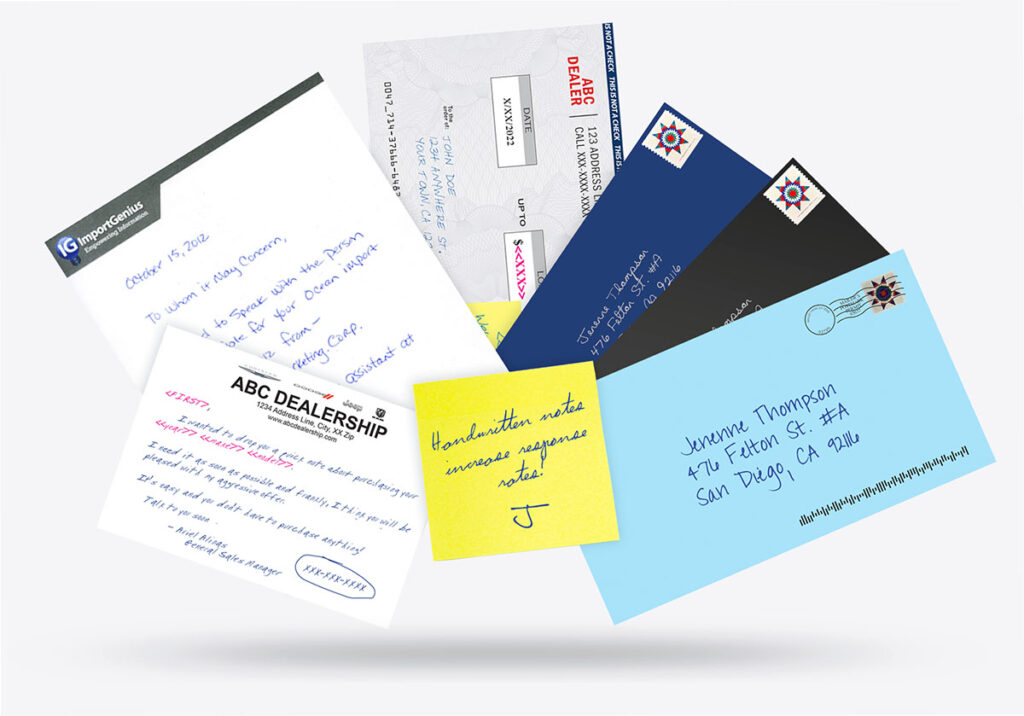Direct Mail...Re-Invented
Make a personal connection and skyrocket your ROI with handwritten personalization for direct mail
Think Ink Marketing elevates direct mail response with precision, personalization, and innovation. Our handcrafted campaigns cut through the clutter, ensuring your message isn’t just seen—it’s remembered.
- Bulk Hand Addressing
- Handwritten Letters
- Handwritten Notes
- And More

We Make Direct Mail Personal


We specialize in High Response Direct Mail
At Think Ink Marketing, we turn direct mail into a powerful, high-response marketing tool. Our specialty is handcrafted, personalized campaigns that cut through the noise and demand attention. With handwritten envelopes, customized messaging, and precision targeting, we help businesses connect with their audience in a way that feels authentic and drives real results. When you need direct mail that delivers, Think Ink.
Direct Mail is the
Highest
Performing
Media
for Direct Response Marketing?
Direct mail is back as the highest-performing direct marketing medium because it delivers a tangible, personalized experience that captures attention and drives response rates higher than digital alternatives. Unlike emails or online ads that can be easily ignored or lost in the clutter, direct mail is physically handled, creating a stronger emotional connection with recipients.
According to the Direct Marketing Association - March 2024
Our direct marketing strategies deliver what others can’t
The Opened Envelope
It means the message inside was seen and read. The number one reason mail campaigns underperform or even fail is simple: the envelope was never opened. Digitally addressed mail often gets dismissed as just another solicitation.

Typical Digitally Addressed
Mail Open Rate
Hand Addressed
Open Rate
Think Ink Marketing makes your mail impossible to ignore. Our hand-addressed envelopes stand out in the mailbox, creating curiosity and a personal touch that dramatically increases open rates—and the success of your campaigns.

Our strategy begins with
Hand-addressed Envelopes
Create a powerful first impression, capturing attention and significantly boosting your ROI.
You want every marketing dollar to count—not end up in the trash. Think Ink Marketing’s innovative strategies ensure your message gets opened and seen by your target audience. The intrigue of a hand-addressed letter sparks curiosity, making it nearly impossible to ignore. The result? More opens, more reads, and more engagement.
Studies show hand addressed envelopes ensures your message gets
Open & Read







Hand Addressed Mail 99.2%
Open Rate
Our handwritten strategy takes your message to the next level with
Handwritten Letters, Cards, Notes & More
Make a personal connection at first contact!
Build Trust
Boost Engagement
Drive Results


Hand Addressed Envelope
with Live Stamp
Build curiosity and a personal connection at first contact
Handwritten
Personalized Letter
Convey thoughtfulness of someone personally writing a note just for the recipient.
You just cant get that Personal Touch with digital ads
Handwritten personalization creates a sense of authenticity and individuality that stands out in a sea of generic, mass-produced content. A hand-addressed envelope or personalized note grabs attention, sparks curiosity, and conveys genuine care, making recipients more likely to open, read, and engage with your message. This personal touch builds trust and fosters meaningful connections, ultimately driving higher response rates and campaign success.

Your Creativity is the limit
We Can Handwrite Anything
Real Pen-On-Paper
Handwritten Envelopes Letters Cards Notes

Successful Projects
Years in business
Team Members
We have
Proven Solutions
for just about any business
Ad Agencies
Automotive
Business Coaching
Political / Survey
College Planning
Dental Services
Entertainment Events
Financial Institutions
Funeral Planning
Health & Wellness
Home Improvement
Hotels & Casinos
Insurance
Investment
Legal
Home Mortgage
Non Profit / Charity
Precious Metals
Real Estate
RV / Boat Dealers
Lasik Eye Care
Sports & FItness
Travel
and More
Thats the power of
Handwritten Personalization
Better Leads Make Better Customers


WhatDirect Marketing Legends Have to say
Dan S. Kennedy is a leading consultant for direct-marketing companies and entrepreneurs and the author of several best selling "Marketing & Sales" books

I’ve never experienced such a dramatic boost in response until I used Think Ink’s handwritten personalization. Not only did my leads increase, but the quality improved significantly—making them easier to close. I believe in Think Ink so much that I dedicated an entire chapter to them in my books..
Let's Get
Started
Whether you’re looking to revitalize struggling campaigns or launch a lead-generating powerhouse, Think Ink Marketing is here to help.
Call us toll free at (888) 808-2161 or fill out the form, and one of our marketing professionals will gladly arrange a call to provide all the details you need. We can even help you set up an A/B test to compare our solution against your current marketing campaigns.

Book A Discovery Call
For more information or to schedule a demo just fill out the form below and we will be in touch usually within 24 hours.
For faster service call us direct at (888) 808-2161
Direct Marketing Insights
Discover more ways handwritten personalization can boost your marketing campaigns in to lead generating machines
How to skyrocket your direct mail open rates!
In the digital age, where inboxes are overflowing and ads are often ignored, direct mail remains a powerful marketing tool....
Read MoreThe Power of Handwritten Marketing: Transforming Customer Engagement
Handwritten marketing is transforming customer engagement by adding a personal, authentic touch that digital channels can’t replicate. In an era...
Read More3 Game-Changing Tips to Supercharge Your Direct Mail Campaigns
In an era dominated by digital marketing, direct mail continues to stand out as a powerful tool to grab attention...
Read More






